Intel Launches Coffee Lake Xeon E (Entry): The Next-Gen E3-1200
by Ian Cutress on July 12, 2018 12:00 PM EST- Posted in
- CPUs
- Intel
- Xeon
- E3-1200
- Coffee Lake
- Xeon E
- Xeon-E
- E3-1200 v7
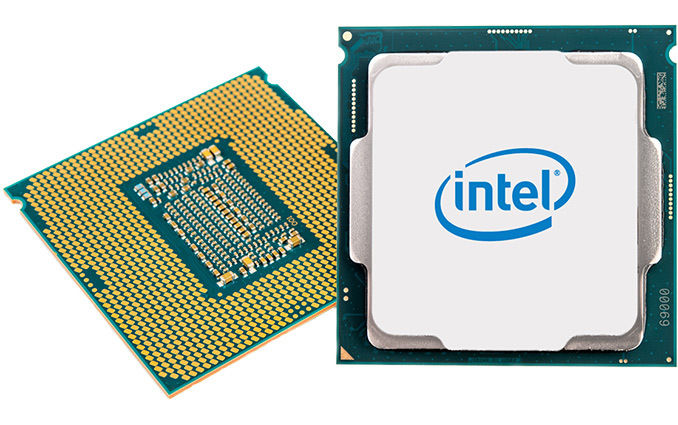
Today Intel is announcing the Xeon E family of processors. The Xeon E-2100 stack of CPUs will replace the previous generation E3 v6 processors, following Intel's renaming of their whole Xeon stack, and in line with the workstation-focused Xeon W-2100 family, and the Xeon D-2100 family. The new processors mirror the current Coffee Lake Core processors on the market and will support up to 64GB of ECC memory, but require motherboards with a specalized workstation C246 chipset. The E in this case stands for 'Entry', and these processors aim to be the cornerstone of Intel's portfolio of entry-level workstation parts.
The new family of processors will have four core and six core parts, mostly with hyperthreading, and mostly with integrated graphics, much like the Coffee Lake Core 8000-series CPUs. In order to differentiate the models with integrated graphics, these parts will have a 'G' after the name. All the processors are built on Intel's 14++ process technology, offering base clocks up to 3.8 GHz and single core turbo up to 4.7 GHz. At this time Intel is not disclosing all-core turbo frequencies or AVX2 frequencies. TDP will mostly be 71-80W, except for the high-end six-core processor which will be at 95W. All processors will support up to dual channel DDR4-2666 Non-ECC and ECC UDIMM modules. Intel also confirmed that the interface between the CPU and heatspreader is a polymer-based thermal interface material (TIM), not soldered.
Despite the same pin configuration as the consumer parts (LGA1151), they will require Xeon E-enabled motherboards with the C246 chipset, and will not work in 300-series motherboards. They will also not work in C236-based motherboards, even though they have the same socket, due to Intel's product segmentation policies. Intel confirmed that the new C246 chipset will have an integrated wireless controller inside, and will require a CRF module on board in order to enable it (much like the second generation of 300-series chipsets). The C246 motherboards are set to support Xeon E, Pentium, Celeron, and Core i3 processors only, and not Core i5/i7. At the present time, Intel did not comment on any future parts that may or may not have 8 cores.
Out of the processors that are in the stack, three are without hyperthreading and three are without integrated graphics. Intel did disclose the per-core turbos for each processor after the launch, showing that most of the processors will be 4.1-4.3 GHz at all core turbo, meaning that the load power values will be pushing well into their PL2 numbers. Intel stated that for all the parts with integrated graphics, the base frequencies were 350 MHz, however the turbo peak frequencies were 1200 MHz for the 218x and 217x models, 1150 MHz for the 212x to 216x models, and 1100 MHz for the E-2104G. The E-2104G is what is known as an off-roadmap model, built only for specific customers, and in our briefing Intel iterated its desire to only speak about the ten 'on-roadmap' models as part of this release. However other companies have noted that this part exists.
All the processors have 16 PCIe lanes from the CPU, and 24 lanes from the chipset (which has an upstream limit of four lanes), and much to our chagrin and to obfuscate the issue, Intel will advertise these processors as having '40' PCIe lanes. We do not see the reason why Intel needs to obfuscate this, as they have never needed to in previous generations, and it makes zero sense unless all the PCIe lanes were equal. We have beat on this door several times previously with Intel, but we never seem to discuss it with (or influence) the person who actually makes that decision.
The top end part, the Xeon E-2186G, will peak at a 3.8 GHz base frequency, and have a single core turbo of 4.7 GHz. Comparing to the consumer line, this is +100 MHz on the base frequency over the Core i7-8700K, although the Xeon has ECC, is not overclockable, and will have a tray price of $450. It is worth noting that in previous generations Intel's top end Xeon E3-1200 chip was often around $650, and more than $200+ the second best processor, and that isn't happening here. This seemed very 'un-Intel' when we saw it for the first time. Intel's official response was that they offer 'price points that will be compelling to OEMs and we expect more opportunities from a solutions perspective''. This response doesn't really address the issue of why there isn't a top $600+ SKU anymore, leaving a card on the table which states that we should probably expect higher-end models to come out at a later date. Roadmaps have already leaked that Intel is preparing an 8-core consumer product later this year, so I can imagine that an equivalent Xeon E processor will also be made available.
| Intel Xeon Naming Strategy | ||||||||
| SNB | IVB | HSW | BDW | SKL-SP | Future | |||
| Servers | E7-8000 | 'v1' | v2 | v3 | v4 | Xeon SP Platinum Xeon SP Gold Xeon SP Silver Xeon SP Bronze |
||
| E7-4000 | 'v1' | v2 | v3 | v4 | ||||
| E7-2800 | 'v1' | v2 | - | - | ||||
| E5-4600 | 'v1' | v2 | v3 | v4 | ||||
| E5-2600 | 'v1' | v2 | v3 | v4 | ||||
| E5-2400 | 'v1' | v2 | v3 | - | ||||
| Workstations | E5-1600 | 'v1' | v2 | v3 | v4 | Xeon W | ||
| E5-1400 | 'v1' | v2 | v3 | - | - | - | - | |
| SNB | IVB | HSW | BDW | SKL | KBL | CFL | ||
| Mobile | E3-1500M | - | - | - | - | v5 | v6 | Xeon E |
| Consumer | E3-1200 | 'v1' | v2 | v3 | v4 | v5 | v6 | Xeon E |
| Comms | E3-1100 | 'v1' | v2 | - | - | - | - | - |
| Network | Xeon-D | - | - | - | D-1500 | D-2100 | ||
As we've mentioned before, Intel's new naming scheme for the Xeon platforms has been a relatively haphazard transition, with the description of the direct translation of how parts compare to the previous generation being minimal at best. Xeon E is arguably the easiest transition to make: what used to be the E3-1275 v6 in the stack is now the Xeon E-2176G, with the 6 representing the number of cores. Intel now also has three '2100' lines of processors: Xeon D-2100, Xeon W-2100, and Xeon E-2100. They're all aimed at different markets, and the numbering of each model has no correlation to the same number in a different segment. So your guess as to why this matters is as good as ours.
One interesting thing came to the forefront of our pre-briefing however. In our slide deck, when discussing which 14nm process was being used, both 14++ and 14+++ were mentioned. If you like more 14-plus variants, Intel does too. I'm sure that this was an error on the part of the speaker, as we know that Coffee Lake is 14++.
We've been discussing on and off with Intel about sampling the Xeon E-series processors for review for over six months, when the first leaks started to come out. We were told yesterday, finally, that the business unit is not planning to seed the press review units. A similar situation happened with the E3-1200 v6 processors. So immediate press reviews will not be forthcoming.
Finally, systems with Xeon E will be being announced from today from the major OEMs.


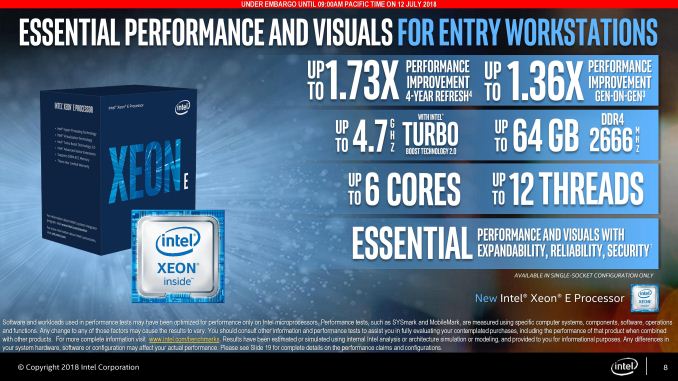
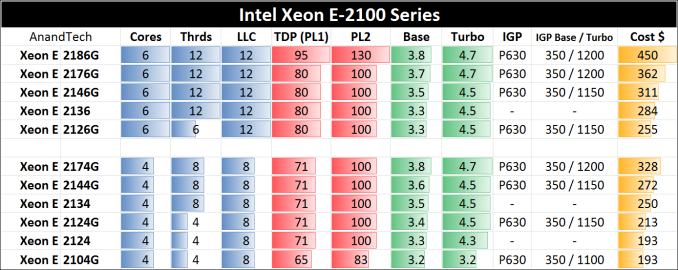
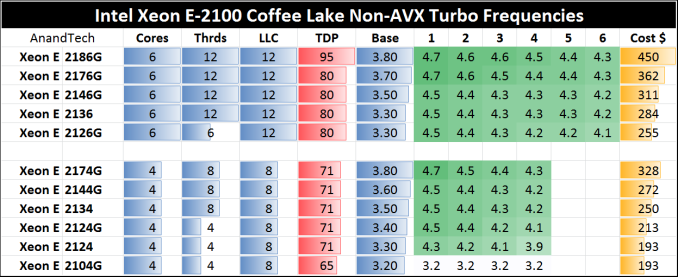
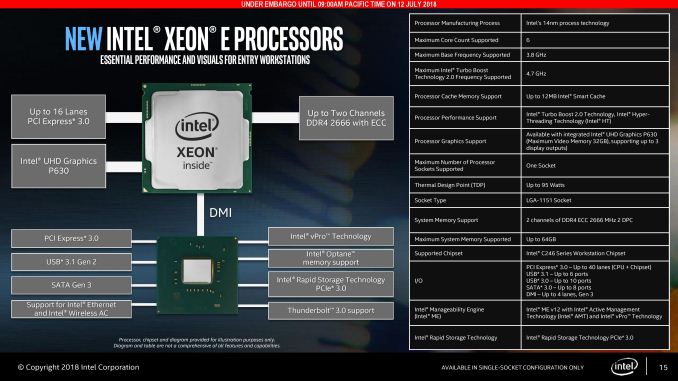














40 Comments
View All Comments
GreenReaper - Thursday, July 12, 2018 - link
Surely one reason for the drop in price is that that these CPUs are still subject to a performance penalty for Meltdown and Spectre mitigations, and therefore offer a less compelling value? Nobody in their right mind wants to drink poisoned coffee if they can wait a year and grab an iced mocha.Stiff competition in the form of Ryzen and Threadripper might be another factor.
hansmuff - Thursday, July 12, 2018 - link
Apt comment. My money is going to AMD for now, just because they have less of those issues and lose less performance on the fixes.Samus - Friday, July 13, 2018 - link
If I were building a PC right now I'd have to agree, my money would go to AMD. Partially because they are entirely competitive, but also partially because Intel has been such a bastard about socket\chipset fragmentation between generations. I think it really started with Haswell\Broadwell when they basically encouraged everyone to upgrade from 80-series to 90-series to guarantee future gen support, which they didn't really deliver (Broadwell on the desktop was basically vaporware) then forced everyone to upgrade again to 100-series for Skylake, which turns out was NOT necessary because the 90-series addressed the technical power delivery incompatibility with Skylake via FIVR bypass.So they did it for money. And they got a pass. So they are continuing to do it, now on the professional\enterprise platforms where the real money is. No better way to milk corporate than force them to replace entire SERVERS to upgrade a single generation of CPU.
The problem for AMD is and will continue to be mobile. The 8th gen Core-U is just a monster. 4 core\8 threads in 15w, with a decent iGPU. The Ryzen can't touch that, because at best it can only match the physical core count and even then the cores are weaker.
Death666Angel - Friday, July 13, 2018 - link
The few reviews of Ryzen U APUs I've seen had them trading blows with the respective Intel parts in general compute scenarios and destroy them in anything gaming related. The problem is still in battery life, where Intel laptops still outshine AMD ones (not sure if it's an APU/chipset thing or just manufacturer laziness in not optimizing enough). And price is not as competitive as I'd have hoped. Often times AMD APU laptops cost about as much as the Intel equivalent with an MX150 GPU. Which is just weird.Yuriman - Friday, July 13, 2018 - link
Businesses don't reuse motherboards, they replace entire PCs. The consumer segment who reuse motherboards are such a small percent of total market that it's probably not even worth considering. Backward and forward compatibility (or lack thereof) is almost certainly related to something else.Spunjji - Friday, July 13, 2018 - link
Remember, though, it's not a 15W CPU. If you want anything like the promised performance out of those 8th gen cores then you're running at 25W minimum, usually closer to 35W - that's why so many Lenovo systems have dog-awful performance under any kind of sustained load.0ldman79 - Friday, July 13, 2018 - link
That is true.I will say this though, dropping the voltage of my Skylake mobile drops the power usage dramatically and it will push the turbo a lot harder and keep the temps down quite a bit.
There is a lot of headroom with Intel mobile, if they'd bother to make sure the temps stay lower than 90*C, which honestly isn't that hard once the voltage is lowered.
blublub - Friday, July 13, 2018 - link
Sorry but this just isn't entirely true:I have an HP Elitebook G5 with Ryzen 2700u - Cinebench 15 multi score is 650 after one run and averages at 545-550 after the 3rd run and stays there - that is almost exactly the score the flagship 15w of Intel 8650u will score (see notebookcheck) - the differences here is marginal with the Intel scoring 675 - Intels lead here is almost none existent.
Battery runtime is impossible to compare for end users, we have to wait for a propper review here. But Intel will likely pull ahead here with 20% I would guess
Ian Cutress - Thursday, July 12, 2018 - link
"Nobody in their right mind wants to drink poisoned coffee if they can wait a year and grab an iced mocha."Consumers yes. Business will get what they need to when they need to, especially when the extra money made from investing now will pay for itself. The only time I hear businesses delay purchasing hardware are big supercomputing projects / datacenter scale-outs waiting on the next generation.
mode_13h - Thursday, July 12, 2018 - link
Yeah, the original comment assumes flexibility on purchasing timeline. Sometimes, people need a [new] PC *now* and just have to choose from what's currently available.As an aside, I sort of doubt that CPUs with the fixes in hardware are going to be as fast as someone living dangerously with a current-gen CPU in an unpatched system. I wish these mitigations could be limited to ring 0, 1, and 2. Sadly, too much sensitive data is handled in ring 3.